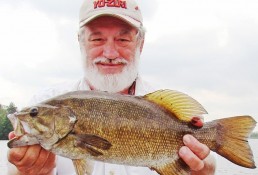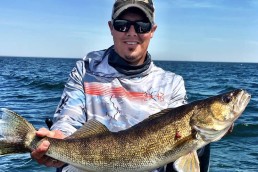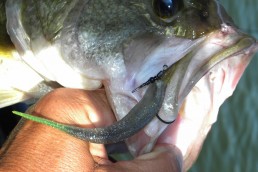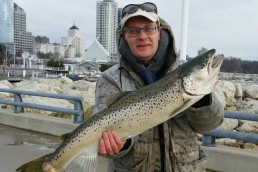Grubs Shine for Tough-bite, Clear-water Smallies
SHARE THIS POST
If I am fishing a clear-water lake for smallmouths and I am hit with a cold front, I will usually start and finish the day with either a grub or a swimbait. That is not to say that my clients and I don’t try other presentations, it is just that grubs and swimbaits shine when the conditions get tough.
One guide trip that comes to mind was when I had a few southern clients who never fished a clear, natural lake. I told them that the smallmouth action is more consistent on the river than the lake. Although my clients knew the action might not be as good as it had been the last two days on the river, they wanted to learn how to fish clear-water lakes for smallmouths.
I picked them up in the morning and told them we were going to a 1,000-acre lake with a good smallmouth population that had some huge fish. On the way to the boat landing I told them that even though a minor cold front had passed overnight, we still had overcast skies, which would work in our favor. I explained that the smallmouths would be either suspending over open water or structure, holding tight to cover or buried in the deep weeds. One of my clients asked what kind of lures we would be using and I quickly replied, “Grubs!” I told them that those Hubs Chub topwater bites that we smoked the smallmouths with the last two days would remain in the tackle box today.
After I launched the boat I told my clients that it would be trial and error until we found some smallmouths and developed a pattern. I told my clients that the first place we would be heading was a large point and that I was looking for them to be suspended off the deep edge of the point. I killed my outboard about 100 yards short of the point and put down my electric trolling motor. I gave one client a 3/8-ounce darter head jig and a 3-inch black grub and the other client a 3/8-ounce darter head jig with a 3-inch watermelon grub.
When we got 50 yards off the point I stopped the boat and grabbed my rod with a 3/8-ounce darter head jig with a 3-inch green-pumpkin grub. I suggested that my clients watch what I do since it is the perfect retrieve after a cold front. I made a long cast with the aid of my 7-foot rod and 4-pound-test monofilament line—this was in the days before fluorocarbon line. After the grub hit the water, I let it sink for about 10 seconds then jerked the rod tip, causing the grub to dart rapidly. I then reeled in the grub with a slow, steady retrieve. After I retrieved the grub about four cranks of the reel, I repeated the jerking action. After I jerked the rod the third time and started my retrieve, I connected with a nice 17-inch smallmouth.
It did not take long for my clients to catch one and the first hour of fishing yielded six nice smallmouths from the deep edge of the point. After we landed the sixth smallmouth the action stopped and I told my clients that we had either caught all the active smallmouths suspending off the point or we had caught the only one suspending off it. We continued to fish the entire point with grubs and a variety of crankbaits and plastics, and could not stick one fish.
Are you enjoying this post?
You can be among the first to get the latest info on where to go, what to use and how to use it!
We proceeded to another point, but the darting technique did not work. After casting several different baits it was obvious that nothing else would work either. Even though we were not catching any, my electronics showed several schools suspended at various levels—they definitely had lockjaw. I told my clients that it was time to make another move and that this time we would see if we could snag a few out of the weeds.
Our next spot was a deep weedline. I easily found the weedline, but my electronics showed no fish. I explained to my clients that even though my electronics gave us the impression that no fish were present, we were still going to fish here and that grubs would remain the bait of choice. The big difference would be in the way that we would be presenting the grubs.
I stressed to them that after making a long cast parallel to the weedline, it would be important to let the grub fall to the bottom. After it fell to the bottom and they had slack in their line, I told them to start a steady, slow retrieve back to the boat. I positioned my boat so the two anglers could cast as parallel to the weedline as possible. I also stressed that we did not want to cast into the weeds, but just work the grub along the weed edge. Cold-front smallmouths have a habit of holding just inside the weeds at the base of the weedline, and if the grub is too far from the base of these weeds, a big smallmouth will not chase it.
It took a while before one of my clients felt life on the end of the line, but it was well worth the wait. The guy in the front of the boat commented that he could not tell if he was dragging the bottom or if he was getting light strikes. I told him that due to the cold front he should not expect hard strikes and that he would need to concentrate and be patient. I added that we were using light line and medium-light-action rods so a soft hook-set would work best. My client was surprised when the next light bite turned out to be a chunky 19-inch smallmouth. They caught several by swimming grubs along the deep weedline and every smallmouth ended up pushing 18 inches or better.
After lunch we returned to the first point where we had all the early-morning action. We tried darting the grub, but had no success. I moved closer to the point and my electronics showed a big school of smallmouths suspending about a foot off the bottom. I told my clients to drop the jigs and let them hit the bottom, tighten up the line and give their jig a short hop. They repeated the procedure several times and eventually started catching smallmouths. I told them that if we were using round jig heads the grub would not be sitting horizontal in the water and the fish would not be hitting the grubs. My clients were amazed at how they had caught this species three different ways with the darter head and grub combination.
Mike Mladenik is a knowledgeable smallmouth bass fisherman and one of the region’s top guides. Over the past 30 years, his clients have landed over 3,000 20-inch smallmouths and hundreds of hawgs over 6 pounds. For more smallmouth bass tips or Hubs Chub Topwater Bait, go to bigsmallmouthbass.com.
MWO
SHARE THIS POST
Did you enjoy this post?
You can be among the first to get the latest info on where to go, what to use and how to use it!
Mike Mladenik
Mike Mladenik has been guiding for more than 30 years in Northern Wisconsin. Recognized as one of the top smallmouth bass experts in North America, he has boated 4,000+ smallmouth over 5 pounds and a few hundred over 6 pounds. Mike has authored 10 fishing books and gives seminars at sports shows across the Midwest. For more info: bigsmallmouthbass.com or 715-854-2055.



